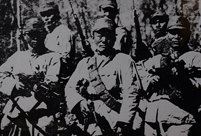 Ballerinas anywhere but onstage
Ballerinas anywhere but onstage
 Top 10 safest airlines in the world
Top 10 safest airlines in the world
 Top 10 most popular instant messaging apps in the world
Top 10 most popular instant messaging apps in the world
 Inspiring shadow images of Chinese army
Inspiring shadow images of Chinese army
 Models shine Xinjiang auto show
Models shine Xinjiang auto show
 From laid-off worker to int'l referee in bodybuilding
From laid-off worker to int'l referee in bodybuilding
 Selected photos of 'two sessions'
Selected photos of 'two sessions'
 Most unusual taxis around the world
Most unusual taxis around the world
 Bridge Worship Festival in Taijiang, SW China
Bridge Worship Festival in Taijiang, SW China
LHASA, March 28 -- Celebrations to mark the sixth anniversary of Serfs' Emancipation Day were held in Tibet Autonomous Region on Friday.
More than 3,000 people gathered at the Potala Palace Square in the regional capital of Lhasa on Friday morning, watching a national flag raising ceremony and singing the national anthem.
In 2009, the regional legislature established March 28 as a day to commemorate Tibetan democratic reform that ended the feudal serf system in 1959. The reform freed 1 million Tibetan serfs, or 90 percent of the region's population at that time.
Wearing his traditional woolen pulu coat specially made for important occasions, Basang Cering, 37, a doctor working in the Tsejolin village near Lhasa, traveled by public transport for two hours to attend the ceremony in the square.
"People of my parents' generation, mostly born to serfs' families, have often told me they couldn't imagine living as they do today when they were kids, because at that time they couldn't find enough food to eat or clothes to wear," said the doctor.
Government statistics show that Tibet's GDP increased to 80.77 billion yuan (13 billion U.S. dollars) last year from 174 million yuan (23.67 million) in 1959.
Meanwhile, per capita disposable income for urban residents in Tibet reached 22,561 yuan (3,629 U.S. dollar) in 2013, while it hit 6,578 yuan (1,058 U.S. dollar) for rural residents.
"Our life is getting better with the good policies of the government. The emancipation not only changed their fates, but also mine," Basang Cering said.
In a park behind the Potala Palace, locals and tourists surrounded a makeshift stage, watching performances incorporating dancing, singing and dramas depicting Tibetan life after the emancipation.
Cering Zhoiyar, who is in her 60s, went to watch the show with her friends after finishing her daily praying around the Jokhang Temple in downtown Lhasa.
"Old memories flashed back," said the former serf, pointing to scars on her arms "left by my 'master'."
The emancipation allowed her to regain freedom and lead a decent life, she said.
"My children have grown up and have good jobs. I often tell them to cherish life today," Cering Zhoiyar added.
For the Thangka artist Lop, the emancipation meant an opportunity for him to promote traditional silk scroll painting, which used to be only enshrined in monasteries or nobles' homes, among ordinary people.
The 35-year-old runs a Thangka gallery in the Jokhang Temple, and the attraction is very popular among pilgrims and tourists.
"I will work hard to better inherit the essence of Thangka art so as to let more people know about Tibet, its history and culture," he said.
 Female journalists at 'two sessions'
Female journalists at 'two sessions' Interpreters serving 'two sessions'
Interpreters serving 'two sessions' Female SWAT team in Chongqing
Female SWAT team in Chongqing Top 10 safest airlines in the world
Top 10 safest airlines in the world Old photos of Anti-Japanese War
Old photos of Anti-Japanese War Mysterious 'Dolan Tribe' in Xinjiang
Mysterious 'Dolan Tribe' in Xinjiang A bite of Luoping County
A bite of Luoping County This is Shanghai
This is Shanghai Chinese airborne troops complete parachute training in various training bases
Chinese airborne troops complete parachute training in various training bases Ballerinas anywhere but onstage
Ballerinas anywhere but onstage Most unusual taxis around the world
Most unusual taxis around the world Micro-expression at 'two sessions'
Micro-expression at 'two sessions' Bridge Worship Festival in Taijiang, SW China
Bridge Worship Festival in Taijiang, SW China Hollywood documentary brings Diaoyu Islands truth to new audience
Hollywood documentary brings Diaoyu Islands truth to new audience Miss HK and actresses shine at flower show
Miss HK and actresses shine at flower showDay|Week|Month